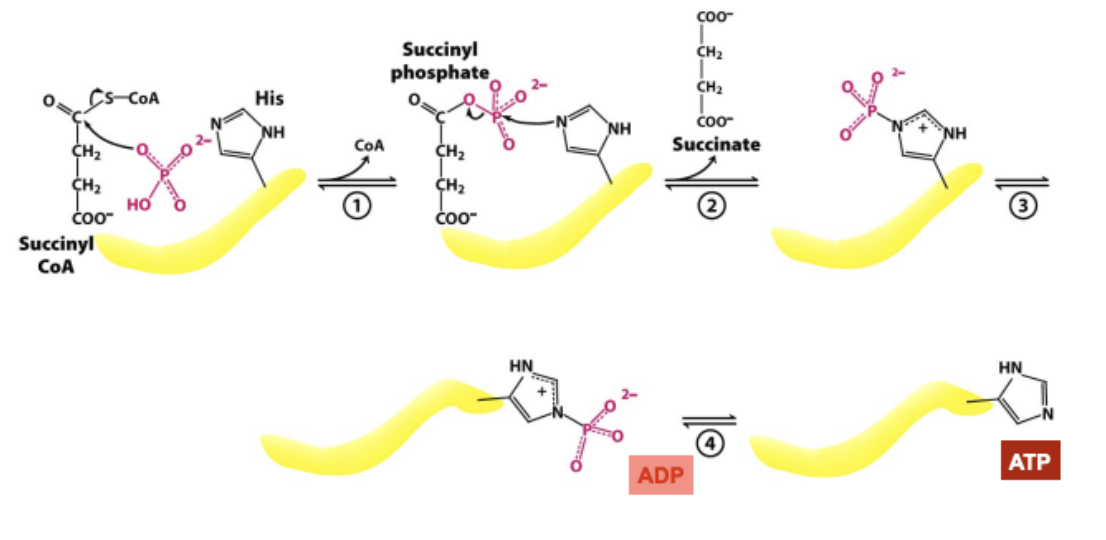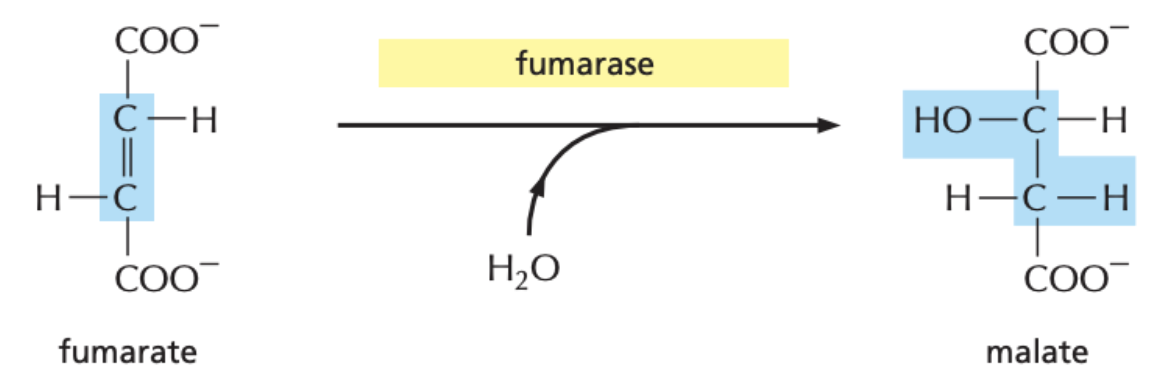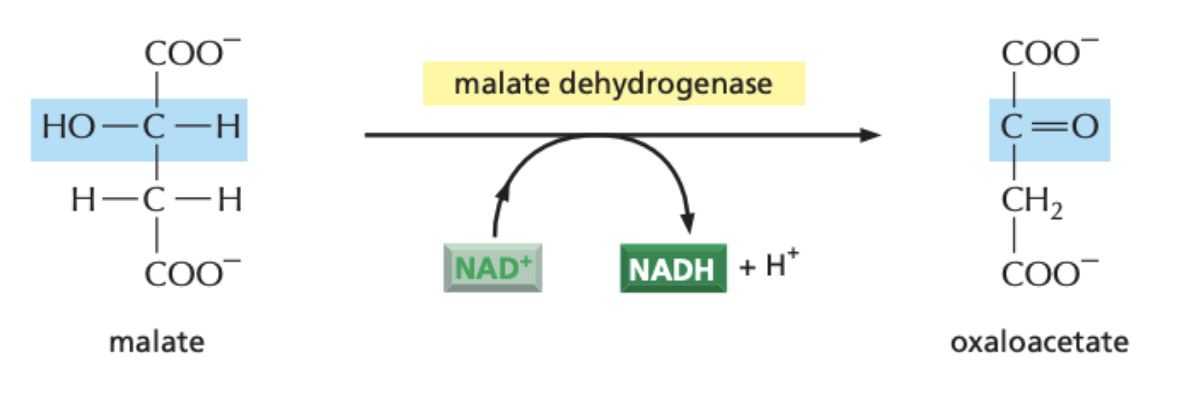lecture 27 + 28
0.0(0)
Card Sorting
1/20
Earn XP
Study Analytics
Name | Mastery | Learn | Test | Matching | Spaced |
|---|
No study sessions yet.
21 Terms
1
New cards
enzyme involved in citrate formation
citrate synthase
2
New cards
step 1: citrate formation
* citrate synthesis removes a proton from the methyl group on acetyl CoA forming a CH2- that acts as a nucleophile towards the carbonyl group of oxaloacetate
* the energetically favourable hydrolysis of the CoA-intermediate drives the forward reaction
* the energetically favourable hydrolysis of the CoA-intermediate drives the forward reaction

3
New cards
enzyme involved in citrate isomerisation
aconitase
4
New cards
step 2: citrate isomerisation
* aconitase isomerises citrate (tertiary alcohol) by first removing water and then adding it back shifting the hydroxyl group from carbon 3 to carbon 4
* makes the next reaction (oxidation of isocitrate) easier as now breaking C-H rather than C-C bond
* makes the next reaction (oxidation of isocitrate) easier as now breaking C-H rather than C-C bond

5
New cards
enzyme involved in the first decarboxylation
isocitrate dehydrogenase
6
New cards
step 3: the first decarboxylation
* in the first of four steps, isocitrate dehydrogenase catalyses the oxidation of carbon 4- the hydroxyl group being converted to a carbonyl
* an NAD+ molecule is reduced in the process
* the intermediate formed is unstable and is rapidly decarboxylated - producing 𝛂-ketoglutarate and CO2
* an NAD+ molecule is reduced in the process
* the intermediate formed is unstable and is rapidly decarboxylated - producing 𝛂-ketoglutarate and CO2

7
New cards
the importance of CO2
evolution of CO2 (decarboxylation) gives a strong thermodynamic pull to a reaction because:
* CO2 is very stable (more stable than reactant) R-COOH ⇌ RH + CO2
* it easily escapes from the site of reaction (highly soluble in water and membrane soluble)
* there are more products than reactant (+ve entropy)
* CO2 is very stable (more stable than reactant) R-COOH ⇌ RH + CO2
* it easily escapes from the site of reaction (highly soluble in water and membrane soluble)
* there are more products than reactant (+ve entropy)
8
New cards
enzyme involved in the second decarboxylation
𝛼-ketoglutarate dehydrogenase complex
9
New cards
step 4: the second decarboxylation
* 𝛼-ketoglutarate dehydrogenase catalyses the oxidation of the carbon 5 from +3 to +4 by carboxylation to release CO2 and oxidation of the carbon 4 from +2 to +3
* the oxidation (-ΔG) is coupled to formation of NADH and formation of succinyl CoA (+ΔG)
* the oxidation (-ΔG) is coupled to formation of NADH and formation of succinyl CoA (+ΔG)

10
New cards
enzyme involved in ATP formation
succinyl-CoA synthetase
11
New cards
step 5: ATP formation
* succinyl-CoA synthetase catalyses the energetically favourable hydrolysis of the thioester bond and its replacement with a phosphodiester bond (using a phosphate from solution) forming succinyl phosphate
* the phosphate group is then transferred to ADP to form ATP (substrate level phosphorylation)
* the phosphate group is then transferred to ADP to form ATP (substrate level phosphorylation)

12
New cards
succinyl-CoA synthetase mechanism
* Coenzyme A is first displaced by a bound phosphate group, forming succinyl phosphate
* this histidine side-chain then removes the Pi group forming succinate and phosphohistidine, the Pi group is then transferred to ADP to form ATP, substrate level phosphorylation
* this histidine side-chain then removes the Pi group forming succinate and phosphohistidine, the Pi group is then transferred to ADP to form ATP, substrate level phosphorylation

13
New cards
enzyme involved in succinate oxidation
succinate dehydrogenase
14
New cards
step 6: succinate oxidation
* succinate dehydrogenase, a transmembrane protein bound to the inner mitochondrial membrane, uses an FAD cofactor to oxidise succinate to fumarate
* FAD is the cofactor reduced rather than NAD+ since the free energy change for this reaction is insufficient to reduce NAD+ (C=C bond weaker than C=O bond so less free energy released when it is formed)
* FAD is the cofactor reduced rather than NAD+ since the free energy change for this reaction is insufficient to reduce NAD+ (C=C bond weaker than C=O bond so less free energy released when it is formed)

15
New cards
enzyme involved in fumarate hydration
fumarase
16
New cards
step 7: fumarate hydration
* fumarase converts fumarate to malate by adding water across the C=C bond forming a hydroxyl group
* facilitating the oxidation in step 8 by avoiding necessity for C≡C formation
* facilitating the oxidation in step 8 by avoiding necessity for C≡C formation

17
New cards
enzyme involved in malate oxidation
malate dehydrogenase
18
New cards
step 8: malate oxidation
malate dehydrogenase uses NAD+ to convert hydroxyl group of malate to a carbonyl group thus regenerating oxaloacetate and completing the cycle

19
New cards
biological logic of the Krebs cycle
* oxidation of acetate to 2 x CO2 requires C-C bond cleavage
* C-C bond cleavage usually occurs between the 𝛼 and ꞵ carbons adjacent to a carbonyl group (e.g. step 4 of glycolysis) or via cleavage of an 𝛼-hydroxyketone
* neither of these strategies is possible with acetate, there’s no ꞵ-carbon present and the second method would require hydroxylation - not energetically favourable for acetate
* hence by condensing acetyl CoA with oxaloacetate to form citrate it generates a ꞵ-cleavage site, allowing full oxidation
* C-C bond cleavage usually occurs between the 𝛼 and ꞵ carbons adjacent to a carbonyl group (e.g. step 4 of glycolysis) or via cleavage of an 𝛼-hydroxyketone
* neither of these strategies is possible with acetate, there’s no ꞵ-carbon present and the second method would require hydroxylation - not energetically favourable for acetate
* hence by condensing acetyl CoA with oxaloacetate to form citrate it generates a ꞵ-cleavage site, allowing full oxidation

20
New cards
what type of cycle is the citric acid cycle
amphibolic cycle
21
New cards
the Warburg Manometer
* measured the change in pressure caused by O2 uptake during respiration by a homogenised tissue sample
* CO2 is absorbed by the filter paper soaked on KOH
* substrate reagents added in side flask and mixed by tipping
* CO2 is absorbed by the filter paper soaked on KOH
* substrate reagents added in side flask and mixed by tipping